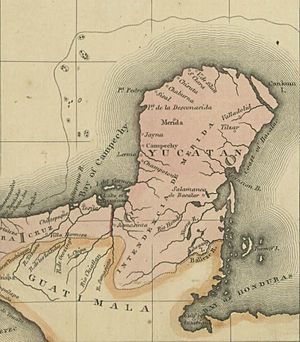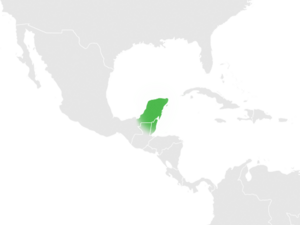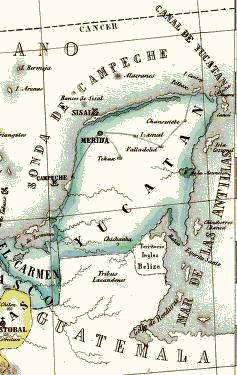Captaincy General of Yucatán facts for kids
Quick facts for kids Province of Yucatan
Provincia de Yucatán (Spanish)
|
|||||||||||
|---|---|---|---|---|---|---|---|---|---|---|---|
| Province of New Spain | |||||||||||
| 1527–1821 | |||||||||||
|
|
|||||||||||
 Map of Yucatan showing the provincial capital of Merida in the northwest.
|
|||||||||||
| Anthem | |||||||||||
| Marcha Real (Spanish) "Royal March" |
|||||||||||
| Capital | Merida 20°58′N 89°37′W / 20.967°N 89.617°W |
||||||||||
| Government | |||||||||||
| • Type | Absolute monarchy with theocratic and oligarchic features | ||||||||||
| • Motto | Plus ultra (Latin) "Further Beyond" |
||||||||||
| Viceroy | |||||||||||
|
• 1535–1550
|
Antonio de Mendoza (first) | ||||||||||
|
• 1821
|
Juan O'Donojú (last) | ||||||||||
| Governor | |||||||||||
|
• 1527–1540
|
Francisco de Montejo (first) | ||||||||||
|
• 1821
|
Juan María Echeverri (last) | ||||||||||
| Legislature | Real Audiencia of Mexico | ||||||||||
| Historical era | Spanish conquest to Spanish American wars of independence | ||||||||||
|
• Start of Spanish conquest
|
September 1527 | ||||||||||
|
• Declaration of independence
|
15 September 1821 | ||||||||||
| Subdivisions | |||||||||||
| • Type | Municipality | ||||||||||
| • Units |
|
||||||||||
|
|||||||||||
| Today part of | |||||||||||
The Province of Yucatan (yuu-KƏ-tahn; Spanish: Provincia de Yucatán) was an important area in the Yucatán Peninsula. It was a major part of the Viceroyalty of New Spain, which was how Spain governed its lands in North and Central America. This area was also known by other names, like the Captaincy General of Yucatan.
Geography
The Yucatán Peninsula is a large, flat area of land, about 300,000 square kilometers (115,831 sq mi). It has a tropical climate and is surrounded by the Gulf of Mexico and the Caribbean Sea. Much of the land is made of karst, which means it has limestone that dissolves easily, creating caves and sinkholes.
History
Spanish Arrival and Conquest
Before the Spanish
Before the Spanish arrived, the Yucatan Peninsula was home to many different Maya states. These states were called kuchkabalo'ob. Some of them might have been part of larger Maya empires like Chichen Itza and Mayapan in the past.
The Maya people probably first heard about the Spanish in 1502. This was after Christopher Columbus landed on an island nearby. The first Spanish people to actually reach the peninsula were Juan Díaz de Solís and Vicente Yáñez Pinzón in 1508. They were on a scouting trip.
Later, in 1511, two Spanish shipwreck survivors, Jerónimo de Aguilar and Gonzalo Guerrero, ended up in Yucatan. They were taken in by a local Maya leader.
Fighting between the Spanish and Maya began on March 5, 1517. A Spanish group from Cuba, led by Francisco Hernández de Córdoba, was attacked by Maya warriors. The Spanish explorers then reported finding grand Maya cities. These reports led to more Spanish trips to the area, which eventually helped lead to the conquest of the Aztec Empire between 1519 and 1521.
The Spanish Conquest Begins
On December 8, 1526, Charles I of Spain, the King of Spain, gave Francisco de Montejo special permission to conquer the Maya states in Yucatan. This permission was called a capitulación de conquista. Montejo was given important titles like governor and captain general of Yucatan.
Montejo left Spain with four ships and over 250 men in June 1527. He arrived in Cozumel in September 1527. The Spanish conquest of Yucatan officially started in 1527 when they founded a settlement called Salamanca de Xelha. The conquest was long and difficult, lasting until 1544. It ended with the founding of Salamanca de Bacalar.
After the Conquest: The Great Maya Revolt
In 1546, some Maya leaders who had recently been defeated started planning a big uprising. They wanted to attack the Spanish cities of Merida, Valladolid, and Bacalar. Six other Maya provinces joined them.
On the night of November 8–9, 1546, the revolt began. Around 500–600 Maya people who were not allied with the rebels, and fifteen to twenty Spanish settlers, were killed. The attack on Merida failed, but Valladolid was surrounded. Spanish soldiers from Merida broke the siege of Valladolid about two weeks later. The attack on Bacalar also turned into a blockade, which was broken in early 1547.
Even though they were defeated, the Maya rebels continued fighting using guerrilla warfare tactics. By March 1547, most of the rebel forces were defeated or had given up. After the revolt, some of the main leaders were tried and executed. About 2,000 Maya prisoners were illegally enslaved. Also, some Spanish military captains were found guilty of war crimes.
The Captaincy General
In 1617, the Captaincy General of Yucatán was created. This gave the Yucatán Peninsula more control over its own affairs. Before this, it was directly ruled by a simple governor under the authority of the Real Audiencia of Mexico, a high court. Spain created these Captaincies General to help protect its lands in the Caribbean from other European powers.
With the new title of captain general, the governor of Yucatan had more power in managing the province and its military. The Captaincy General was still part of the Viceroyalty of New Spain. This meant the viceroy could still oversee the province if needed, and the Audiencia of Mexico handled appeals in legal cases. The Captaincy General covered a large area, including parts of what are now Campeche, Quintana Roo, Tabasco, Yucatán, and even northern Petén and Belize.
A Spanish law from 1680 stated that the Governor of Yucatán had to follow the orders of the Viceroy of New Spain. This showed that even with more autonomy, Yucatan was still under the viceroy's authority.
Later Changes and Independence
In 1786, Spain made more changes to how it governed its colonies. They created an Intendancy of Yucatán. The Intendancy took control of government money and military funds. It also had broad powers to help the local economy grow.
On September 15, 1821, the city of Mérida declared Yucatan's independence from Spain. Soon after, the governor, Juan María Echeverri, sent people to discuss joining the First Mexican Empire. Yucatan officially became part of the Mexican Empire on November 2, 1821.
Society
Religion

When Francisco de Montejo was given permission to conquer Yucatan in 1526, his orders included plans to convert the Maya people to Roman Catholic Christianity. Christian missionaries, including priests and Carmelite friars, arrived with Montejo in 1527.
The first known Christian baptisms in the peninsula happened in Ekab, a Maya province, between December 1527 and March 1528. Later, Franciscans began missionary work in Chak'anputun between 1535 and 1537.
Education
Spanish-Christian schooling for Maya children and adults started in 1547. Franciscan friars taught at the Provincial Convent of St. Francis in Merida.
The lessons included:
- Roman Catholic beliefs for all Maya children and adults.
- Reading and writing (in Latin) for children from important Maya families.
- Choral music for Maya adults.
Some Maya priests and noble families strongly opposed this Franciscan teaching.
Government
Early Government Structure
The rules for governing Spanish Yucatan were first set out in the capitulaciones de conquista (letters patent) given to Francisco de Montejo in 1526.
The King of Spain had absolute power. He was advised by important groups like the Casa de Contratación and the Council of the Indies. Below the King was the adelantado, who was also the governor, captain general, and chief law enforcement officer of Yucatan. This person had executive, legislative, and judicial power over the province.
Spanish Yucatan was divided into municipios (municipalities). Each municipality was managed by a cabildo, which was a town council. These municipalities were further divided into:
- Maya settlements, often called encomienda settlements. These were managed by a Spanish encomendero and a local Maya leader called a batab or cacique.
- Spanish settlements, which were managed by a cabildo.
Changes Over Time
The Real Audiencia of Mexico, a high court, was set up in 1527. It became the main court for Spanish Yucatan. In 1535, Yucatan became an administrative district of the Viceroyalty of New Spain.
New laws passed in 1542 changed some parts of the adelantado's special permission. In 1549, the adelantado was even suspended from his roles as governor, captain general, and chief law enforcement officer of Spanish Yucatan.
Economy
Economic Plans for Settlers
Francisco de Montejo's special permission from 1526 included rules to encourage Spanish settlers to come to the Yucatan Peninsula. These rules offered several benefits:
- Spanish settlers could be given control over Maya settlements, called encomiendas. This meant they could collect tribute from the Maya people.
- They were allowed to take a limited number of Maya prisoners as slaves.
- They received some tax breaks on things like the quinto real (royal fifth of gold), trade taxes, and salt tax.
- They were given land grants for farming and building homes.
- Money collected from court fines could be used for local public projects.
- Money from the diezmo (a church tax) could be used for missionary work in the area.
Main Economic Activities
At first, the Spanish conquistadors hoped to find lots of gold and valuable metals in Yucatan. But as the conquest continued, it became clear there wasn't much gold. So, farming became the main economic activity in Spanish Yucatan. Trade, especially in dye woods, also grew.
In late 1542, Maya cotton blankets, called mantas, were made legal money.
See also
 In Spanish: Capitanía General de Yucatán para niños
In Spanish: Capitanía General de Yucatán para niños
- History of Belize
- History of Central America
- History of Mexico
- Republic of Yucatan – a state that existed in the Yucatan peninsula in the 1800s
- Caste War of Yucatan – a conflict between Spanish and Maya people in the Yucatan peninsula in the 1800s





